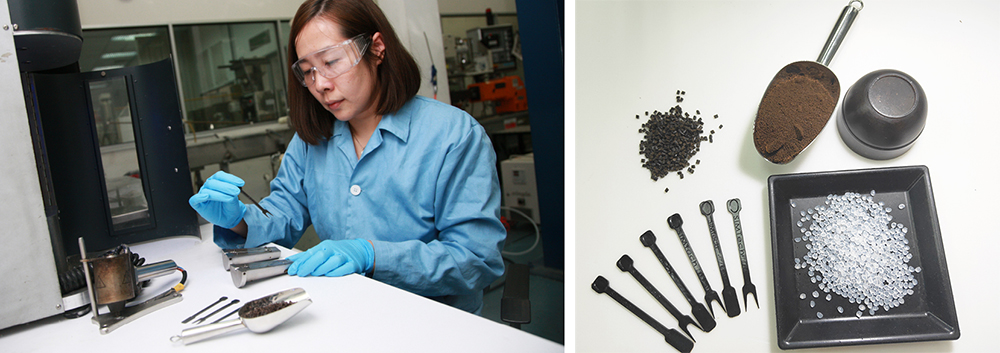
FEATURES
From Coffee Beans to Cups
Composites recycled from coffee grounds improve environmental sustainability

In the sustainable circular economy, things that are conventionally treated as waste in a linear economy is now a resource. A case in point is spent coffee grounds.
Coffee, a widely drunk beverage around the world, uses much coffee beans in its brewing. This continuously generates great amount of spent coffee grounds. The estimated world coffee consumption is 161.93 million bags of coffee in coffee year 2017/18. This is an increase of 1.8 per cent as compared with coffee year 2016/17 [1]. With almost 50 per cent of the world coffee production used for soluble coffee preparation, up to 6 million tons of spent coffee ground (SCG) are generated annually [2].
Nowadays, the most common way to discard spent coffee ground is through landfills and incineration. However, this will cause direct effect on the environment due to the enormous amount of methane and carbon dioxide produced when coffee ground decomposes. To minimise its impact on the environment, it is important to repurpose coffee ground into something useful. Since spent coffee grounds are cellulosic material that are insoluble, it can be applied in composites in the same manner as other cellulosic material as fillers, such as wood chips and other natural fibres.
Producing composites from coffee waste is an effective method to reduce plastic consumption and food wastes
This is exactly what SIMTech has achieved. A thermoplastic-based recycled coffee ground composite is developed. Sustainable in-house processing routes have been designed and tested to verify its reliability for application in coffee cups. Further modification also helped to improve adhesion between polymers and coffee grounds resulting in more durable products. The environmental footprint of coffee cups has also been investigated during the study in comparison with single used plastic and paper cup. Better sustainability of coffee cups has been observed after certain washing cycles. Applications of the coffee composites include the manufacture of non-structured components as well as household articles.
For enquiries, please contact
Dr Ng Sum Huan Gary, Acting Deputy Director, SEAC
Email: shng@SIMTech.a-star.edu.sg
Web: www.a-star.edu.sg/SIMTech-SMC![]()
Notes
1 International Coffee Organisation. (2018). Coffee Market Report. Retrieved from: http:// www. ico.org
2 Tokimoto, T, Kawasaki, N, Nakamura, T, Akutagawa, J, & Tanada, S (2005). Removal of lead ions in drinking water by coffee grounds as vegetable biomass. Journal of Colloid and Interface Science, 281(1), 56-61
A*STAR celebrates International Women's Day

From groundbreaking discoveries to cutting-edge research, our researchers are empowering the next generation of female science, technology, engineering and mathematics (STEM) leaders.
Get inspired by our #WomeninSTEM
.png?sfvrsn=843a4005_8)